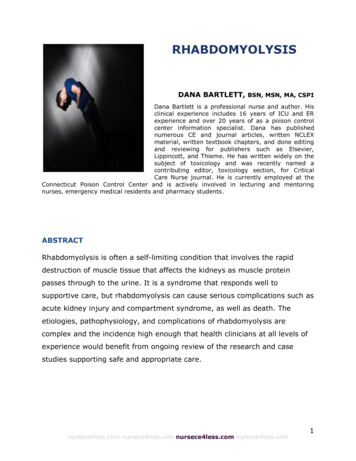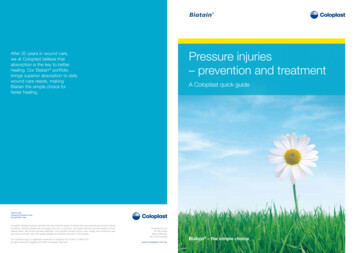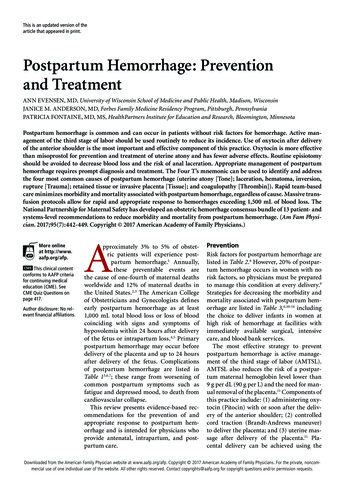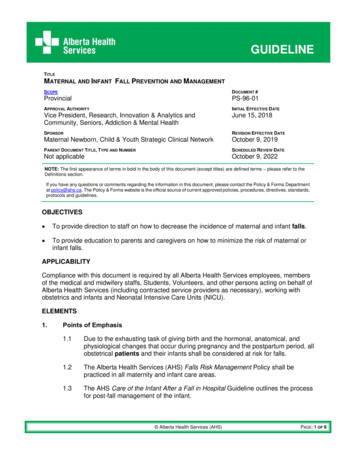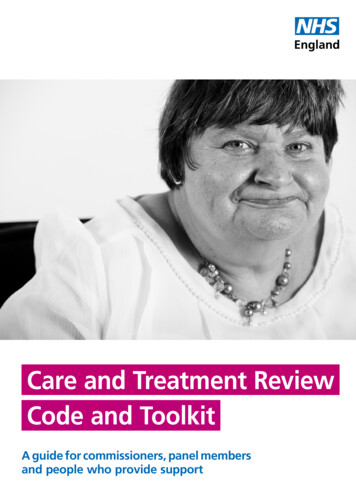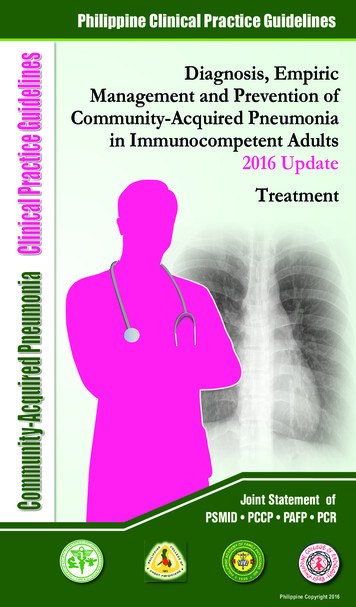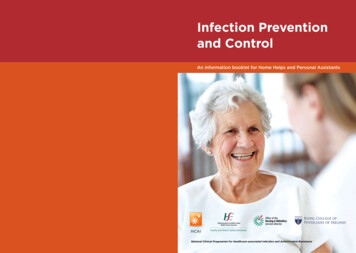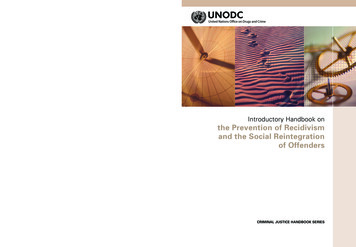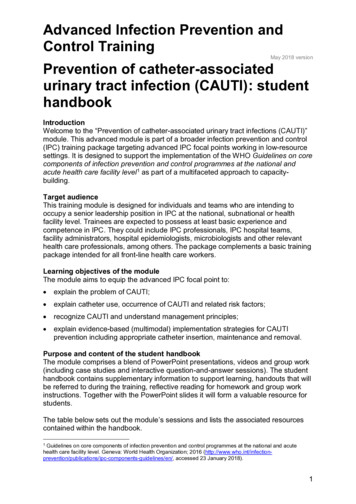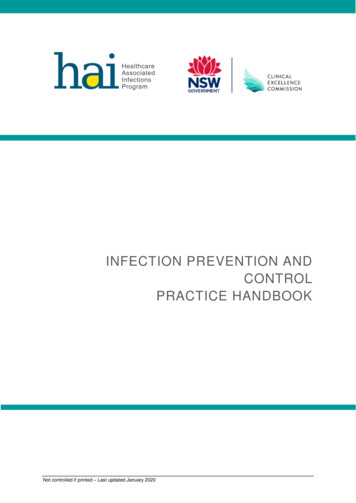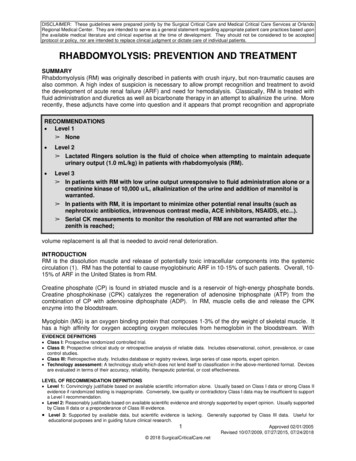
Transcription
DISCLAIMER: These guidelines were prepared jointly by the Surgical Critical Care and Medical Critical Care Services at OrlandoRegional Medical Center. They are intended to serve as a general statement regarding appropriate patient care practices based uponthe available medical literature and clinical expertise at the time of development. They should not be considered to be acceptedprotocol or policy, nor are intended to replace clinical judgment or dictate care of individual patients.RHABDOMYOLYSIS: PREVENTION AND TREATMENTSUMMARYRhabdomyolysis (RM) was originally described in patients with crush injury, but non-traumatic causes arealso common. A high index of suspicion is necessary to allow prompt recognition and treatment to avoidthe development of acute renal failure (ARF) and need for hemodialysis. Classically, RM is treated withfluid administration and diuretics as well as bicarbonate therapy in an attempt to alkalinize the urine. Morerecently, these adjuncts have come into question and it appears that prompt recognition and appropriateRECOMMENDATIONS Level 1 None Level 2 Lactated Ringers solution is the fluid of choice when attempting to maintain adequateurinary output (1.0 mL/kg) in patients with rhabdomyolysis (RM). Level 3 In patients with RM with low urine output unresponsive to fluid administration alone or acreatinine kinase of 10,000 u/L, alkalinization of the urine and addition of mannitol iswarranted. In patients with RM, it is important to minimize other potential renal insults (such asnephrotoxic antibiotics, intravenous contrast media, ACE inhibitors, NSAIDS, etc.). Serial CK measurements to monitor the resolution of RM are not warranted after thezenith is reached;volume replacement is all that is needed to avoid renal deterioration.INTRODUCTIONRM is the dissolution muscle and release of potentially toxic intracellular components into the systemiccirculation (1). RM has the potential to cause myoglobinuric ARF in 10-15% of such patients. Overall, 1015% of ARF in the United States is from RM.Creatine phosphate (CP) is found in striated muscle and is a reservoir of high-energy phosphate bonds.Creatine phosphokinase (CPK) catalyzes the regeneration of adenosine triphosphate (ATP) from thecombination of CP with adenosine diphosphate (ADP). In RM, muscle cells die and release the CPKenzyme into the bloodstream.Myoglobin (MG) is an oxygen binding protein that composes 1-3% of the dry weight of skeletal muscle. Ithas a high affinity for oxygen accepting oxygen molecules from hemoglobin in the bloodstream. WithEVIDENCE DEFINITIONS Class I: Prospective randomized controlled trial. Class II: Prospective clinical study or retrospective analysis of reliable data. Includes observational, cohort, prevalence, or casecontrol studies. Class III: Retrospective study. Includes database or registry reviews, large series of case reports, expert opinion. Technology assessment: A technology study which does not lend itself to classification in the above-mentioned format. Devicesare evaluated in terms of their accuracy, reliability, therapeutic potential, or cost effectiveness.LEVEL OF RECOMMENDATION DEFINITIONS Level 1: Convincingly justifiable based on available scientific information alone. Usually based on Class I data or strong Class IIevidence if randomized testing is inappropriate. Conversely, low quality or contradictory Class I data may be insufficient to supporta Level I recommendation. Level 2: Reasonably justifiable based on available scientific evidence and strongly supported by expert opinion. Usually supportedby Class II data or a preponderance of Class III evidence. Level 3: Supported by available data, but scientific evidence is lacking. Generally supported by Class III data. Useful foreducational purposes and in guiding future clinical research.1Approved 02/01/2005Revised 10/07/2009, 07/27/2015, 07/24/2018 2018 SurgicalCriticalCare.net
muscle damage, free MG in the blood leads to myoglobinemia. Normally, low levels are well tolerated andare cleared by the reticuloendothelial system. At high levels, however, binding and normal clearingmechanisms become saturated, eventually leading to myoglobinuria and the potential for renal injury andARF. Myoglobinuria is the presence of MG in the urine. The urine is found to be “positive” for blood despitethe absence of erythrocytes on microscopic examination. MG contains iron, the toxic effects of which aredescribed below. MG also has the potential to release vasoactive agents such as platelet activating factorand endothelins which may lead to renal arteriolar vasoconstriction, thus worsening renal function. MGappears first in the plasma, but is rapidly cleared within 24 hours. CPK appears a few hours later than MG,reaches its peak value within the first 24 hours, and remains at such levels for several days. CPK isconsidered to be a more useful marker for the diagnosis and assessment of the severity of muscular injurydue to its delayed clearance from the plasma.A prerequisite for the development of this disease process is muscle injury, the causes of which arenumerous and outlined below. While low levels of ischemia ( 1.5 hours) are typically well tolerated, as theischemic time lengthens irreversible muscle damage occurs allowing the release of toxic metabolicbyproducts. Reperfusion after a period of ischemia contributes to localized tissue edema mediated byleukocytes, leukotrienes and inflammatory mediators. Cell membranes are damaged, cellular contents leak,and intracellular ATP, the main fuel for cellular membrane pumps, is depleted worsening cellularhomeostasis. Another problem is the development of intracellular hypercalcemia leading to the activationof intracellular autolytic enzymes that damage cell membranes leading to the cells vulnerability to oxygenfree radicals with reperfusion.There are various causes of RM: vascular interruption, ischemia-reperfusion, crush injury, improper patientpositioning, alcohol ingestion, seizures, extreme exercise, electrical injury, infection, hyperthermia, andsteroids and neuromuscular blockade (especially in combination). With heightened suspicion for thisdisorder, non-traumatic causes are being seen with increasing frequency.A special group that has recently been seen to be at risk is bariatric surgery patients. RM is increasinglybeing seen in clinical practice as the popularity of bariatric surgery is gaining momentum. Severallongitudinal studies have found rates of RM after bariatric surgery ranging from 7-77%. A rare syndromeleading to RM specifically related to these patients is known as gluteal compartment syndrome.PHYSIOLOGICAL BASIS OF TREATMENT MODALITIESThe most important component with regard to the treatment of patients with RM is the ability to recognizethe disease process in a timely fashion to prevent the consequences of myoglobinuria. Worsening renalfunction as evidenced by increasing blood urea nitrogen (BUN) and creatinine, oliguria, classic “tea coloredurine”, and an elevated serum CPK level all but make the diagnosis. Other findings include hypocalcemia,hyperkalemia and the potential for cardiac toxicity, hyperuricemia, hyperphosphatemia, lactic acidosis, anddisseminated intravascular coagulation (DIC) from thromboplastin release.The cornerstone of treatment is aggressive volume resuscitation and expansion of the extracellular fluidcompartment. Other modalities described include the use of bicarbonate in an attempt to alkalinize theurine, mannitol, and iron chelators (deferoxamine). Prompt and aggressive restoration of volume isessential and critical to prevent progression to ARF and the need for renal replacement therapy and itsinherent cost, morbidity, and mortality. Volume depletion, hypotension and shock combined with afferentarteriolar vasoconstriction due to circulating catecholamines, vasopressin and thromboxane leads todecreased GFR and deficient oxygen delivery to the renal parenchyma. Volume administration can combatsome of these disturbances and also dilutes the MG load and reduces cast formation.High concentrations of MG in the renal tubules cause precipitation with secretory proteins from the tubulecells (Tamm-Horsfell protein) leading to the formation of tubular casts and resultant tubular obstruction tourinary flow. Acidic urine favors this process hence the theoretic benefit of bicarbonate use. These patientsare typically already acidotic and have acidic urine. Bicarbonate use increases MG solubility, induces asolute diuresis and can potentially reduce the amount of trapped MG. Complications of overzealous2 2018 SurgicalCriticalCare.netApproved 02/01/2005Revised 10/07/2009, 07/27/2015, 07/24/2018
bicarbonate administration, however, include hyperosmolar states, “overshoot alkalosis”hypernatremia. The use of Diamox has been used for the development of iatrogenic alkalosis.andMG itself has a direct toxic effect as well. MG contains iron, and this moiety is released when metabolizedin the tubule cell. Normally, the iron molecule is metabolized to its storage form (ferritin). With anoverwhelming load of MG delivered to the kidney, however, this conversion capacity is overwhelmedleading to increased levels of free iron. Iron subsequently becomes an electron donor leading to theformation of free radicals.Mannitol has several potentially beneficial qualities. It is an osmotic diuretic with a rapid onset of action. Incontrast to loop diuretics which inhibit the Na-K /H ATPase in the distal tubule cell leading to aciduria,mannitol does not acidify the urine. It is a volume expander, reduces blood viscosity, and acts as a renalvasodilator increasing renal blood flow and leading to increased GFR. Perhaps more importantly, it hasbeen found to be an oxygen free radical scavenger. Free radicals are molecules with an uneven numberof electrons and in excess can lead to damage of critical cellular ultrastructural elements, lipid membranes,hyaluronic acid and even DNA. Free radicals lead to lipid peroxidation resulting in increased permeability,cellular edema, calcium influx, cell lysis and release of MG, further perpetuating the clinical syndrome ofRM.Another key element in the treatment and prevention of renal failure that deserves mention is the avoidanceof other iatrogenic renal insults such as the use of nephrotoxic antibiotics, IV contrast medium, ACEinhibitors, NSAIDS and so forth.LITERATURE REVIEWRon et al. in 1984 published a review of seven patients treated for crush injuries suffered after the collapseof a building (2). All patients had clinical evidence of myoglobinuria. CPK levels were not drawn. Thevolume of fluid necessary to maintain a diuresis of 300 mL/hr was 568 mL/hr. Mannitol was used (averagedose 160 g/d). The average amount of sodium bicarbonate given over the first five days was 685 mEq.The goal was to maintain a urinary pH of 6.5. Visible myoglobinuria cleared at an average of 48 hoursand at no time did patients have a creatinine of 1.5 mg/dL or require hemodialysis. The authors readilyadmitted that it was impossible to “critically assess the relative beneficial roles of the various componentsof our regimen” for the lack of a control groups with different treatment protocols.Homsi et al. in 1997 performed a retrospective analysis of patients with RM at risk for ARF (3). Theycompared groups receiving saline (n 9) vs. saline, bicarbonate and mannitol (SBM) (n 15). Twenty-fourpatients were evaluated over a four year period. There were no differences in the amount of saline infused(204 vs. 206 mL/hr) or urinary output (112 vs. 124 mL/hr) over the first 60 hours between the two groups.There were no significant differences with respect to age, urea, creatinine, potassium, or bicarbonate levels.There was no ARF (defined as the need for dialysis) in either group. Initial CPK was higher in the SBMgroup (3351 vs. 1747 U/L; p 0.05). The saline group was found to have a somewhat delayed CKdetermination (2.7 vs. 1.7 days), already had a good response to saline infusion and therefore did notreceive mannitol and bicarbonate thus forming the control group. The delayed measurement was postulatedto be the reason for the lower CPK determination in the saline group. The authors concluded thatprogression to established renal failure can be totally avoided with prophylactic treatment, and that onceappropriate saline expansion is provided, the addition of mannitol and bicarbonate therapy seems to beunnecessary.Brown et al. retrospectively investigated the value of bicarbonate and mannitol in preventing renal failure,dialysis and mortality after post traumatic RM (4). ARF was defined as a peak creatinine of 2.0 mg/dL.CPK levels were routinely drawn on all patients. Patients with a CK 5000 U/L (n 382) had a higherincidence of renal failure (19% vs. 8%; p 0.0001). 154 patients (40%) received bicarbonate and mannitolat the discretion of the attending physician. There was no difference in the development of renal failure(22% vs. 18%), need for dialysis (7% vs. 6%), or mortality (15% vs. 18%) between groups receivingbicarbonate and mannitol versus those that did not. Groups were also similar with respect to age, gender3 2018 SurgicalCriticalCare.netApproved 02/01/2005Revised 10/07/2009, 07/27/2015, 07/24/2018
and ISS. The authors concluded that the standard of adding bicarbonate and mannitol therapy should bereconsidered.McMahon et al. performed a retrospective cohort study of 2371 patients admitted to two large teachinghospitals with CPK levels in excess of 5000 U/L within three days of admission (5). The derivation cohortconsisted of 1397 patients from Massachusetts General Hospital, and the validation cohort comprised 974patients from Brigham and Women’s Hospital. The purpose was to develop a risk prediction score for RMleading to ARF. Independent predictors of the need for either renal replacement therapy or in-hospitalmortality (the composite outcome) were age, female sex, cause of rhabdomyolysis, and values of initialcreatinine, CPK, phosphate, calcium, and bicarbonate. The composite outcome occurred in 19.0% ofpatients (8.0% required RRT and 14.1% died during hospitalization). In-hospital mortality was higher inpatients with acute kidney injury (22.5% vs 7.1%, p .001) and substantially higher in patients requiringrenal replacement therapy (40.0% vs 11.9%, p .001). Admission CPK levels were not found to bepredictive of subsequent patient outcome (as has been identified in other studies) (6-9). The compositeoutcome was increased only with admission CPK levels in excess of 40,000 U/L confirming the insensitivityof such measurements. A score of less than 5 was associated with a risk of the primary outcome of 2.3%,while a score of more than 10 was associated with a risk of 61.2%. The risk score is thus particularly usefulin identifying patients at low-risk of either acute kidney injury or in-hospital mortality. It is not as useful inpredicting patients at high-risk however. An online calculator for measuring risk is available here.In a study by Cho et al., lactated ringer's (LR) solution was compared to normal saline (NS) in theresuscitation of patients with doxylamine intoxication and rhabdomyolysis (10). In a cohort of 97 doxylamineintoxicated patients, 28 (31%) were found to have developed rhabdomyolysis, and were randomized toreceive either NS or LR as a primary means of aggressive hydration. Mean CK levels of the NS group andthe LR group were 3282 IU/L and 4497 IU/L respectively. After 12 hours of aggressive hydration (400mL/hour), the amount of sodium bicarbonate administration and the frequency administration of diureticswas significantly higher in the NS group. There were no differences in the time taken for creatine kinasenormalization and nobody required renal replacement therapy in either group.Chakravarrty et al. performed a review of eleven case reports, two case series, six prospective and threeretrospective comparative studies (11). Overall 145 patients with RM were reported following bariatricsurgery. In the comparative studies, 87 RM patients were compared with 325 non-RM patients. The RMpatients were more likely to be male, had a greater mean body mass index (BMI) (52 vs. 48 kg/m2, p 0.01)and underwent a longer operation (255 vs. 207 min, p 0.01) compared to non-RM patients.Pereira et al. wrote a systematic comparison of a case of gluteal compartment syndrome after bariatricsurgery with 3 previous publications for a total of 9 patients (12). Findings included gluteal pain, pale tightswollen buttock, paresthesias and buttock skin breakdown. Five patients developed ARF, three of whichresulted in mortality. Risk factors were found to be super-obesity (BMI 55), operative time 4 hours, andmale gender. The authors concluded that in these high risk patients, routine postoperative CPK andneuromuscular exams may help to identify early signs of gluteal compartment syndrome and RM.Neilsen et al. studied a decade of patients with rhabdomyolysis, specifically looking at patients with CPK’sgreater than 10,000 u/l. Such patients were started on a rhabdomyolysis protocol including intravenousmannitol every 8 hours and sodium bicarbonate administration in addition to usual maintenance fluids withLactated Ringer’s solution. They noted a stark improvement in renal injury and failure compared withpatients who were not initiated into their protocol (26% vs. 70%) (14)TREATMENT PRINCIPLES / ALKALINIZATION OF THE URINE1) In patients with significant rhabdomyolysis (CPK 5,000 IU/L) AND acute renal failure (Cr 2.0 mg/dL),maintain a urinary output of at least 100 mL/hour. Invasive hemodynamic monitoring may be necessaryto ensure adequate volume resuscitation. If such a diuresis is not possible with saline alone, addsodium bicarbonate and mannitol as outlined below until a steady trend towards normalization of CPKis established or until the CPK level is below 5000 IU/L or urinary output averages 100 mL/hour for12 consecutive hours. In addition to the patient’s maintenance IVF (Lactated Ringer's solution), add:a. In patients with a serum sodium 147 meq/L:4 2018 SurgicalCriticalCare.netApproved 02/01/2005Revised 10/07/2009, 07/27/2015, 07/24/2018
½ NS with 100 mEq NaHCO3 / L @ 125 cc / hourb. In patients with a serum sodium 147 meq/L: D5W with 100 mEq NaHCO3 / L @ 125 cc / hour2) Administer Mannitol, 12.5 g IV q 6 hours.3) In patients receiving bicarbonate, check a daily ABG.a. For a pH of 7.15 or a serum bicarbonate of 15 mg/dL bolus with 100 mEq NaHCO3 andrecheck ABG in 3 hours and repeat until the pH is 7.15 AND the serum bicarbonate is 15.b. Discontinue bicarbonate infusion if pH 7.50.REFERENCES1. Visweswaran P, Guntupalli J. Rhabdomyolysis. Critical Care Clinics 1999; 15:415-428.2. Ron D, Taitelman U, Michaelson M, Bar-Joseph G, Bursxtein S, Better OS. Prevention of Acute RenalFailure in Traumatic Rhabdomyolysis. Arch Intern Med 1984; 144: 277-280.3. Homsi E, Barreiro M, Orlando JMC, Higa EM. Prophylaxis of acute renal failure in patients withrhabdomyolysis. Renal Failure 1997; 19: 283-288.4. Brown C, Rhee P, Chan L, Evans K, Demetriades D, Velmahos G. Preventing Renal Failure in Patientswith Rhabdomyolysis: Do Bicarbonate and Mannitol Make a Difference? JTrauma 2004; 56: 11911196.5. McMahon GM, Zeng X, Waikar SS. A Risk Prediction Score for Kidney Failure or Mortality inRhabdomyolysis. JAMA Intern Med 2013; 173(19):1821-1827.6. Chen CY, Lin YR, Zhao LL, Yang WC, Chang YJ, Wu HP. Clinical factors in predicting acute renalfailure caused by rhabdomyolysis in the ED. Am J Emerg Med 2013; 31(7):1062-6.7. Bagley WH, Yang H, Shah KH. Rhabdomyolysis. Intern Emerg Med 2007; 2(3):210-8.8. Kasaoka S, Todani M, Kaneko T, et al. Peak value of blood myoglobin predicts acute renal failureinduced by rhabdomyolysis. J Crit Care 2010;25:601–49. Lappalainen H, Tiula E, Uotila L, Mänttäri M. Elimination kinetics of myoglobin and creatine kinase inrhabdomyol
dialysis and mortality after post traumatic RM (4). ARF was defined as a peak creatinine of 2.0 mg/dL. CPK levels were routinely drawn on all patients. Patients with
